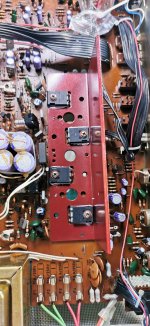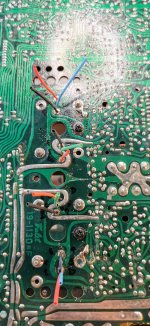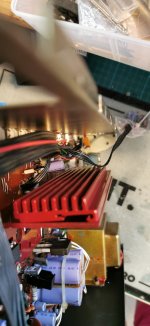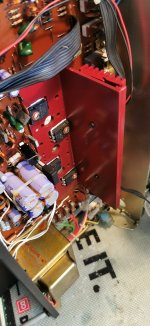That sounds reasonable although the bias control voltage will be different for the FET's. I think that should be OK though.
Set at 1k so that it allows the vbe multiplier to conduct which in turn lowers the voltage across the multiplier and so lowers the bias current.
The transistor should not now be in contact with the heatsink. The FET's have a negative temperature coefficient above around 100 milliamps and so that automatically helps provide all the thermal compensation needed. If the transistor was on the heatsink it would overcompensate and reduce the current to much.
OK got thatThe transistor should not now be in contact with the heatsink. The FET's have a negative temperature coefficient above around 100 milliamps and so that automatically helps provide all the thermal compensation needed. If the transistor was on the heatsink it would overcompensate and reduce the current to much.
And the final thing for today the additional heatsink.Im Not rushing the next bit, I need plenty of time to get it right and I needed things like the heatsink to be finished so I didn't have to take it apart again, but it looks OK
Attachments
o e as in missing an n (lol) or o e as in original equipment (but it didn't have bias presets). So if you mean just one then yes, it it is just the one per channel for bias.
Oh I see lol. That's my phone, sometimes if I'm not looking my thumb hits the space bar and leaves a gapo e as in missing an n (lol) or o e as in original equipment (but it didn't have bias presets). So if you mean just one then yes, it it is just the one per channel for bias.
'Good that you chose to increase the heatsinking. However, the present arrangement probably won't work much better than the plain aluminiun plate unless the fins are vertically aligned so that the "hot air rises" principle can work to speed up airflow and hence cooling. At the much higher dissipation level of any power mosfet in linear hifi mode, cooling can be a challenge when you get to the stage of extended listening tests and I think you'll need a lot more than the little NAD "L" plate and finned booster affords at the moment, before you sign off on this project.
Bob Cordell advises that 100mA bias current is about optimum for each and any type of mosfet output device but most constructors chicken out when the heat level with internal heatsinks becomes a little scary above 50mA. The actual bias level is not critical as it is with bipolar transistors in class AB. The more bias, the merrier in fact - up to a practical limit where you are virtually in class A operation anyway. Skimping on bias at less than 30 mA though, definitely shows up in hi-fi as distortion and unpleasant sound - probably why many low budget attempts at hifi audio products using mosfets haven't been all that popular.
Bob Cordell advises that 100mA bias current is about optimum for each and any type of mosfet output device but most constructors chicken out when the heat level with internal heatsinks becomes a little scary above 50mA. The actual bias level is not critical as it is with bipolar transistors in class AB. The more bias, the merrier in fact - up to a practical limit where you are virtually in class A operation anyway. Skimping on bias at less than 30 mA though, definitely shows up in hi-fi as distortion and unpleasant sound - probably why many low budget attempts at hifi audio products using mosfets haven't been all that popular.
Last edited:
This modded amp should output a max of ~15W per channel in class AB, not exactly extreme for these mosfets even with the wimpy heatsink.
With the amp trimmed to class A, the PSU will probably die before the mosfets.
With the amp trimmed to class A, the PSU will probably die before the mosfets.
Last edited:
probably won't work much better than the plain aluminiun plate unless the fins are vertically aligned so that the "hot air rises" principle can work to speed up airflow and hence cooling
Sugden Class A A21 use horizontal fins... probably for looks I suspect.
- Home
- Amplifiers
- Solid State
- NAD 3020 Series 20 mk-3 MOSFET Output Conversion



